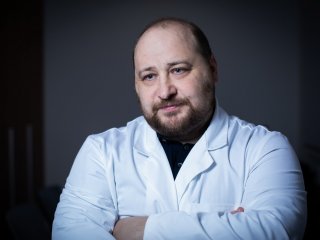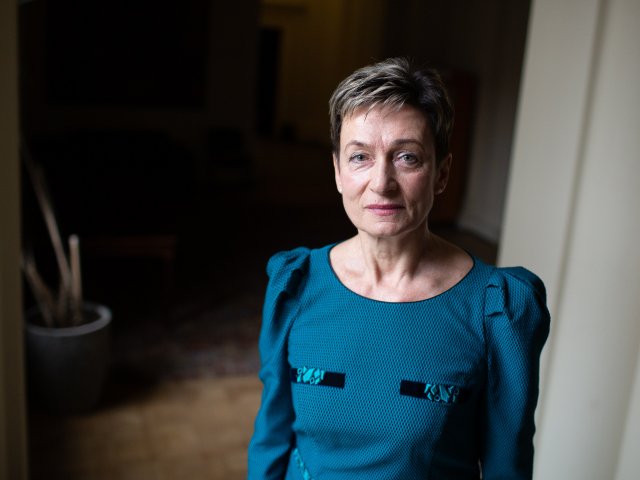The pandemic has stimulated science in an unprecedented way, especially in the field of virology and vaccinology. What do the studies of Sputnik V and Sputnik Lite show? Why has the whole world come to triple vaccination? What fundamental knowledge gained during the pandemic looks the most promising? Denis Yurievich Logunov, a Corresponding Member of the Russian Academy of Sciences, Deputy Director for Science of The Gamaleya National Research Center of Epidemiology and Microbiology, talks about this.
Denis Yurievich Logunov
Photo: Elena Librik, Scientific Russia
— The Russian Sputnik V vaccine was registered in August 2020; mass vaccination began in January 2021. What new data on the effectiveness and safety of the drug have scientists obtained over the past year when Sputnik V began to be widely used to create collective immunity?
— During this time, we have not learned anything fundamentally new regarding the effect of the vaccine on the body from the standpoint of side effects.
That is, Sputnik V is safe. There are almost 400 protocols of clinical trials with adenoviruses and a huge history of application. The entire safety profile for adenovirus vectors is not just clear, but very carefully studied. The Sputnik V vaccine began to be used en masse only after toxicological studies — this is a mandatory requirement of the regulator — and we did not see anything new either in preclinical or clinical trials. By the way, US Army personnel have been getting vaccinated with adenovirus-based vaccines for many years: hundreds and hundreds of thousands of people.
The human body tolerates the vaccine well. All side effects are understandable and are mostly classified as mild adverse events. These are mainly pain at the injection site and fever, which develop in the first two days and disappear within a week.
It is very important that we have received a lot of foreign expert information. Now Sputnik V is registered in 71 countries, more than 100 million doses have been injected. This is huge independent expertise in the field of security: in Argentina, in San Marino, and European countries, for example in Hungary, studies show a very good security profile. Sputnik V is not associated with venous thrombosis, which is much talked about today, and unlike mRNA vaccines, there is no connection with myocarditis.
When it comes to efficiency, the story is more interesting. First of all, it is linked to the evolution of the virus. In The Lancet we published articles about the first, second, and third phases of clinical trials. Analyses of cohort data and civil circulation data at a time when the Wuhan variant was dominant showed that the effectiveness of Sputnik V ranged from 92% to 99%. 99% efficiency was shown by independent studies in Bahrain, in which 184 thousand people participated.
The diversity of variants, including Wuhan, had completely changed by June due to the appearance of the delta strain. Today I see that this variant has spread by 99.9%, only it and its descendants dominate. With this variant, the effectiveness of the vaccine did not fall critically — cohort studies in Moscow showed an 83 percent effectiveness of Sputnik V. Yes, there is a decrease in effectiveness, but it is not dramatic and even lower than what is observed when using mRNA vaccines.
Anyway, due to the variability and evolution of the virus, the regulatory bodies of all countries have come to the third vaccination. In Israel, the US, Europe, and Russia, the Ministries of Health recommended a third booster dose for an immune response. I will additionally emphasize why this is necessary.
One can use different strategies, but the world has now gone down the path tested on the flu virus. All people are immune to the flu, except for newborns who have not yet encountered the virus. But at the same time, for some reason we get vaccinated. This is a very simple situation, which is well understood by people dealing with VRI. The fact is that most viruses that cause viral respiratory infections are extremely variable. By changing, the virus achieves one evolutionary task: we lose part of the effective immunity, part of the T-cell, part of the antibodies that recognized the original virus. That is, due to changes in antigenic determinants, the virus gets a window of opportunity.
In addition, in the case of COVID-19, the incubation period ends within three to five days, on average the same is true for influenza. How much immune memory can we attract to the war against pathogens? On average, the cells double once a day. That is, with a short incubation period, we can increase the immune memory slightly – about 10–20 times. In the case of an infection with an incubation period that lasts 14 days (for example, measles), we will be able to increase the volume of immune memory by 16 thousand times (214). Imagine how many immunocytes we can mobilize to protect the body.
The variability of viruses that cause seasonal and acute respiratory diseases, their short incubation period is the key to their existence. That is, there is immunity, but the virus is working ahead of schedule. This happens with COVID-19: the virus infects even people who have been ill. Immunity decreases, and the virus gets a window of opportunity. In this regard, revaccination remains the only proven way to achieve effective immunity. We are mobilizing our troops, creating inflation of immune memory, among which there will be a huge part of the B- and T-cells that have retained their effect. Due to such inflation, we can protect the body.
I repeat — this is the path that all major regulators have chosen: the United States, Europe, Israel, Russia, and many other countries.
Along with revaccination, an important element of the fight against the virus is the constant monitoring of existing variants, checking their pathogenicity and protective effectiveness of the vaccine, primarily on model animals. In parallel, new versions of the vaccine (with new variants of the S antigen) are being created and tested ahead of time, they are tested in experiments with animals and even limited clinical studies, after which they are deposited in the form of a kind of “cans.” If the delta variant evolves further and the effectiveness of the vaccine falls below the prescribed level, such vaccine variants can be reactivated and introduced into medical practice.
Photo: Elena Librik, Scientific Russia
— Are similar “cans” being created with Sputnik V?
— Yes, of course. This work takes place in the background. As soon as information about the variants of concern appears, the synthesis of the gene encoding the main protective antigen is immediately ordered. New candidate versions of the vaccine are obtained, which are tested on animals. Therefore, we have both the beta variant and the delta variant, and other options in the form of vaccine “cans.”
— One of the popular prejudices about Sputnik V is that the vaccine was developed in a rush. What works of The Gamaleya Center preceded the creation of the vaccine?
— It is no coincidence that I said that adenovirus vaccines and adenovirus vectors are a world experience that is more than 40 years old. The first genome mapping of adenoviruses to create viral vectors based on them took place in the late 1970s. The first recombinant viruses that can be used as vectors were obtained in the early 1980s. The platform for creating adenoviral drugs has been developed for more than 40 years, so there is no reason to talk about some kind of rush.
The first SARS outbreak occurred in 2002 and 2003, and already then, the main approaches were worked out, a protective antigen was determined, antigens that could potentially cause an ADE effect were identified (their presence may be undesirable in vaccines). That is, for 20 years it has been clear which antigen should be used to protect the body from coronavirus.
We have a ready-made technological platform on the go, there are opportunities for rapid synthesis in the country, we do not even need to isolate a pathogen: since Russia has de novo gene synthesis capabilities, we can instantly synthesize the desired gene with only a letter code. Now we can order a gene and create a candidate version of the vaccine in one or two weeks, which we will investigate in preclinical and clinical trials.
This technology has been developing for many years and has reached the level of practical implementation not only in Russia but also in the world. I don’t know why it upsets people.
— Due to many years of research, can prejudices about delayed side effects be discarded?
— We have more than 50 serotypes of adenoviruses, and we contract some of them more than once in our lives. I repeat, in the US Army, several hundred thousand people have been vaccinated with live adenoviruses of the fourth and seventh serotypes. After such vaccination, the relationship was investigated for somatic diseases in remote periods: 20 and 30 years after people were discharged from the army. Scientists have been thinking about the problem, and there are publications that confirm that vaccination with adenovirus drugs is in no way associated with an increase in cases of cancer, heart attacks, or other somatic diseases.
Sputnik V is made on the basis of vectors — the adenoviruses used are devoid of the area (genes) responsible for the replication of the virus. If live adenoviruses do not cause long-term consequences associated with somatic diseases, then the same adenoviruses deprived of the ability to reproduce even more so.
There is a long history of research, this is a huge array of information that can be found in scientific journals. Such prejudices about adenovirus vaccines are simply naive.
— In early November, The Lancet published the results of a study of the Sputnik Lite vaccine. It became another confirmation of its safety and effectiveness. Tell us more about the drug that is being offered for revaccination today.
— Sputnik Lite is the first component of the Sputnik V vaccine.
In 2019, when a worldwide need to create a vaccine against COVID-19 emerged, a large conference of the World Health Organization was held, where it was discussed what the vaccine should be. We clearly understood that we needed prime-boost immunization. We immediately adopted this approach because we learned a lesson well during the appearance of the Middle East Respiratory Syndrome (MERS). It was clear that two consecutive vaccinations were needed to create a stable immunity in a sterile population. At the same time, the whole world presumptuously went for one injection, the possibility of using the vaccine twice was practically not considered. Now everyone has come to the triple use of the vaccine, including Pfizer and Moderna.
In two years, the situation has changed dramatically, a significant number of people who have been ill and vaccinated have appeared, and the immune layer will only grow further. Thanks to our research and the research of our Argentine colleagues, we realized that only one injection can be used to vaccinate those who have been ill and revaccinate those who have been vaccinated. That is, the first dose of Sputnik V is enough to bring the immune response to a peak, for example, in a person who has had COVID-19, if the level of antibodies has dropped to almost zero. Since the immune response develops according to the secondary type, it develops rapidly and strongly.
Thus, for a significant part of the population, only one injection is sufficient.
Naturally, Sputnik Lite can also be used independently. In The Lancet we demonstrate its effectiveness — in young people, it is almost 80%, but slightly lower in the elderly.
Denis Yurievich Logunov
Photo: Elena Librik, Scientific Russia
— Why does Sputnik remain the main vaccine in Russia?
— If you look at modern approaches to creating vaccines, you can see that they have all become platforms. This means that it is no longer necessary to grow a pathogenic virus, use huge sanitary zones and unprecedented measures to protect personnel. It is enough to grow harmless adenoviruses or pack harmless mRNA into a lipid envelope. Such technologies are very easy to broadcast.
Viral vector technology can be deployed anywhere: in China, India, Russia. It is good that in Russia there were companies that deployed production technology at their sites, which was developed at The Gamaleya Center, and brought production capacities to millions of doses per month.
Due to its versatility, this platform easily fits into classic biotechnological processes. If the company has experience in the production of monoclonal antibodies, recombinant proteins, or eukaryotic cells, it can be retrained for the production of vector vaccines in a month.
The situation with mRNA vaccines is somewhat more complicated — there are difficulties with chemical synthesis (lipid synthesis, synthesis of modified nucleotides). But if people have experience, these technologies are also easily broadcast without the need to implement special strict anti-epidemic measures.
— The pandemic is a difficult time, but many say it has advanced science. What new knowledge have we gained in the field of virology and basic research?
— Naturally, studying this pathogen, we have gained a lot of new knowledge. This is a pathogen that has never existed in the human population, but now it is with us forever: I am sure that it will turn into an equivalent of seasonal coronavirus pathogens that have been known for a long time. I think we will move into this situation in the next year or two. But before that, we needed to learn many different things. First of all, in the field of fundamental science, the molecular pathogenesis of the virus was determined at the level of penetration into the cell. Here, doctors quickly picked up the flag from scientists and developed or adapted unique drugs for use. At the beginning of the pandemic, there was a situation when a patient got into intensive care and it was unclear what to do with them; after three or four months, we treated the cytokine storm with monoclonal antibodies. Of course, there was a lot of criticism, supposedly you can’t do everything “off the wheels” and we are taking a lot of risks. In fact, understanding the fundamental processes and facilitating regulatory approaches made it possible to manage the situation from the point of view of vaccination, prevention, and treatment.
Humanity has never reacted so smoothly and promptly to any pandemic. Of course, we have learned a lot.
— Which of the knowledge that we obtained during the pandemic looks the most promising? In which direction does new information push science?
— All existing vector and mRNA platforms will become mainstream. More than a hundred million doses of Sputnik and probably about a billion doses of Moderna and Pfizer vaccines have been released. Most of the vaccines being developed will focus on these platform solutions, they are the future. The results in the field of understanding biology, mechanisms of penetration, and selection of protective antigens will definitely form the basis of future research.
The unprecedented experience of involving medical personnel in anti-epidemic measures will also remain. The developments that are associated with the therapy of cytokine storm and distress syndrome that occurs in the lungs will not go anywhere. This is a huge job that would be impossible in “peacetime.” Now, these results can be translated into conditions that cause other viral infections. I can’t even imagine how many years of “peaceful” time it would take us to obtain so many new tools and knowledge.
— Have you ever faced such an acute challenge as the need to create a COVID-19 vaccine as quickly as possible?
— Of course not. Some tasks required extreme tension, but they were associated with “military operations” that were taking place far abroad. In our case, it was the Ebola and MERS.
The team worked hard, went on expeditions, and conducted clinical trials. It was very difficult: when the epidemic unfolds, the results are needed in a short time, not in six months. But now we were working not just in difficult conditions, the families of employees were at risk. Of course, no one has ever worked in such an environment before.
— Did they spend the nights in the labs?
— I can tell you a lot about this period. In short, people fell asleep in the workplace.
— Is the team in a calm mode now?
— Yes, and it’s good that it’s so. It is impossible to always be in an emergency mode. We have understood a lot (but, of course, not everything) about the virus, developed infectious models, worked out testing methods, and now we can work systematically, without heroism.
— Why did you decide to study microbiology at the time?
— When I studied at the Kursk Medical Institute at the Faculty of Pharmacy, specializing in biotechnology, I could go almost anywhere, but at some point, I just became interested in this topic. I wanted to do science, genetic engineering, and viral vectors. I didn’t think about the prestige of medical specialties.
I entered graduate school, where I began to study the genetic engineering of viruses. Then the work turned to the field of anticancer drugs, vectors for gene therapy of cancer, and various genetic diseases. At the same time, it became clear that adenovirus vectors are an extremely promising platform for creating vaccines.
— How has the pandemic affected the attitude of young people to microbiology? Has the situation spurred young people to engage in this field of science?
— Definitely. Now almost the entire population understands what viruses are, what protective immunity is, and what types of immunity there are. The progress of the population in the field of virology, immunology, and vaccinology is simply incredible. This affected not only young specialists but in general, changed the interest of the entire population of the Earth in the problems associated with epidemics.
The influx of specialists to The Gamaleya Center is quite significant, and this is understandable: our center has been constantly on the radar for the last year. Young specialists want to develop vaccines and drugs. And now our center can teach young people a lot.
The interview was conducted with the support of the Ministry of Science and Higher Education of the Russian Federation and the Russian Academy of Sciences.



























